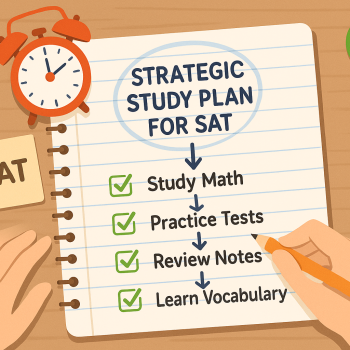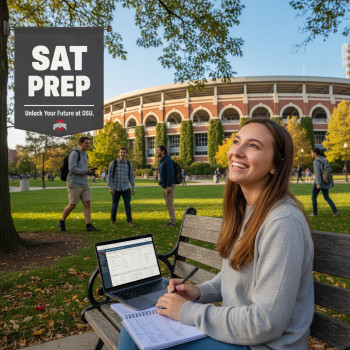How to Prepare for the SAT During a Gap Year
Taking a gap year can feel like opening a second chapter in a book you didn’t realize you were writing. Maybe you want to travel, work, volunteer, or build a portfolio — and maybe you also want to improve your SAT score without the crush of senior-year deadlines. The good news: a gap year is a luxury for SAT prep if you treat it right. With time, space, and the right plan, you can raise your score significantly while growing as a person.
Why a Gap Year Is an SAT Advantage
Most students cram SAT prep into a busy school schedule. During a gap year you have three major advantages: time to practice deliberately, fewer distractions from coursework, and flexibility to design a study plan around real-life experiences. Instead of racing through an overnight review before test day, you can schedule spaced repetition, take more full-length practice tests, and address weak spots with targeted drills.
That doesn’t mean the gap year will automatically translate to better scores — you still need structure, feedback, and consistent effort. But used well, that extra time allows deeper learning and the chance to test multiple strategies (like reading techniques or math approaches) to see what actually works for you.
Quick facts about the SAT (what you must know)
- The SAT measures Evidence-Based Reading and Writing (EBRW) and Math. The total score ranges from 400–1600.
- The essay is no longer a standard part of the SAT; colleges that require writing samples generally use other means for evaluation.
- Practice tests are the single most important tool: they mimic timing, pressure, and stamina, and reveal patterns in your mistakes.
Step 1 — Decide on a timeline: 3, 6, 9, or 12 months
How long you study depends on your starting score, target score, and how much time you can commit each week. Here are common gap-year timelines and who they suit:
- 3 months: For students already near their target score (within 40–80 points) who can study intensely (10–15 hours/week) and focus on test-taking technique and error correction.
- 6 months: A balanced plan for most students. Enough time for steady progress (6–10 hours/week) with opportunity for multiple practice tests and topic cycles.
- 9–12 months: Ideal for big jumps (100+ points), rebuilding fundamentals, or combining prep with travel/work blocks. Allows for slower, deeper learning and review cycles (4–8 hours/week).
Sample 6–month calendar (use as a starting point)
| Month | Focus | Weekly Hours | Milestone |
|---|---|---|---|
| 1 | Diagnostic test, fundamentals (grammar, algebra) | 6–8 | Baseline score and study plan |
| 2 | Reading strategies, vocab-in-context, problem type drills | 6–8 | First sectional practice and targeted drills |
| 3 | Advanced math (functions, geometry), timing work | 6–8 | Second full-length practice test |
| 4 | Mixed practice, pacing, and weak-spot remediation | 6–8 | Focused improvements on weakest section |
| 5 | Full-length practice tests, test-day routines | 8–10 | Simulated test day and review |
| 6 | Final polishing: last drills, sleep & nutrition plan | 6–8 | Target test and score goal |
This table is a blueprint — personalize it. If you find math is your bottleneck, shift two months to focused algebra and problem solving. If reading is your weakness, increase timed passage practice and content reading.
Step 2 — Build realistic weekly schedules and stick to them
Consistency beats marathon sessions. A typical week during a gap-year prep might look like this:
- 2 hours of focused math practice (topic-focused drills)
- 2 hours of Reading practice (timed passages and passage-mapping)
- 1.5 hours of Writing & Language drills (grammar rules and editing)
- 1–2 hours reviewing practice-test mistakes and analyzing patterns
- 1 full-length practice test every 2–3 weeks (increases to weekly in the last month)
On lighter weeks, swap in real-world activities: volunteer shifts, work, or travel that still leave space for 6–8 quality hours of study. Use travel time for passive prep: audiobooks on logical reasoning, grammar podcasts, or mental math practice.
Step 3 — Section-by-section strategies that actually work
Evidence-Based Reading & Writing
Reading and Writing often feel like two different beasts, but they share key practices: clarity, context, and pattern recognition.
- Active reading beats passive skimming. For each passage, try a quick passage map: 1–2 sentences summarizing the main idea of each paragraph and the author’s tone or purpose.
- Practice identifying question types: main idea, detail, inference, function, and vocabulary-in-context. Each type has a go-to strategy: for detail questions, pinpoint the line reference; for inference, look for what the passage implies rather than states.
- For vocabulary-in-context, prioritize context clues over flashcards. You’ll often be able to eliminate answers by testing whether meaning fits the sentence and the author’s tone.
- Grammar rules are finite. Master the common ones: subject-verb agreement, pronoun-antecedent agreement, verb tense consistency, parallelism, punctuation (commas, colons, dashes), and commonly confused words.
Example: If a Writing question asks whether to replace a comma with a semicolon, ask whether two independent clauses are being joined. If yes, semicolon may be right; if not, the comma is wrong.
Math
Math requires a mix of conceptual clarity and speed. The best math prep does three things: shore up fundamentals, practice high-frequency problem types, and build mental math fluency.
- Start with a diagnostic: which areas — algebra, problem solving, advanced math, geometry, or data analysis — give you most trouble? Focus 60% of your practice on the weakest areas and 40% on maintaining strengths.
- Learn to translate word problems into equations. Practice reading for variables and relationships. Box numbers and underline the question being asked.
- Master shortcuts and backsolving. When stuck, plug in answer choices to see which one fits the problem — especially on tricky algebraic or quadratic problems.
- Memorize key formulas (area, volume, circle, quadratic formula) and know when to use them. Use a cheat sheet early in prep and wean off reliance by the final month.
Calculator tip: Know when to use it. On the no-calculator section, practice mental manipulation and paper-pencil strategies to avoid losing time trying to mimic calculator methods.
Step 4 — Practice tests: frequency, review, and realistic conditions
Practice tests are practice tests only if you treat them like data — not ego checks. They should be honest simulations: quiet room, timed sections, no phone interruptions, and the same snacks you plan for test day.
- Early months: take a full-length test every 2–3 weeks to monitor progress without burning out.
- Middle months: increase to weekly or biweekly as your stamina and timing improve.
- Final month: simulated test days every week, with one day dedicated to review and recovery.
Review each practice test thoroughly. Don’t just look at the score — categorize every missed question by type and cause: careless mistake, timing issue, content gap, or misunderstanding the question. This error log will tell you what to fix.
Step 5 — Use feedback loops: analysis, adjust, repeat
A gap year is perfect for iterative improvement. Every 4–6 weeks, review your practice-test logs and adjust your plan. If errors are mostly careless mistakes, add more pacing and stress-management practice. If errors are content-based, spend focused weeks rebuilding fundamentals.
Consider working with a tutor or a small team when you hit a plateau. Sparkl’s personalized tutoring and benefits — 1-on-1 guidance, tailored study plans, expert tutors, and AI-driven insights — can be particularly useful at this stage. A tutor helps translate your error log into practical drills, stays accountable with you, and introduces test-taking strategies you might not find in a book.
Step 6 — Balance: gap-year life and SAT prep
A gap year isn’t an excuse to live in a bubble. In fact, diverse experiences can sharpen reading comprehension (real-world reading) and analytical thinking (work and projects). But balance is key.
- Block your schedule. Reserve consistent study windows (e.g., weekday mornings) and protect them like classes.
- Use micro-study while traveling. Short bursts — 20–30 minutes — of grammar drills or single-passage practice keep momentum without derailing experiences.
- Plan breaks. Burnout on the SAT is real: schedule at least one full day off per week and mini-vacations between study cycles.
College deadlines and test timing during a gap year
If you plan to apply to college after your gap year, be mindful of application timelines. Many colleges have regular decision deadlines in January, and early decision or early action deadlines are often in November. Map your planned SAT test date to give yourself time for re-taking scores if needed and to meet application deadlines.
Rule of thumb: aim to have a reliable, final score at least 3–6 weeks before your application deadline to allow time for score reports and calm final review of submissions.
Tools and resources that fit into a gap-year plan
- Official practice tests are indispensable. Nothing replicates the SAT like the College Board’s practice materials.
- Adaptive practice platforms can help you focus on weak concepts; if you use such tools, complement them with full-length tests to maintain timing.
- Tutoring: a knowledgeable coach helps translate practice-test data into action. Personalized tutoring — whether in short bursts or long-term — is particularly helpful when you want efficient, targeted improvement.
- Study groups: occasional collaborative review sessions (especially for logic puzzles or verbal reasoning) can be motivating, but keep them structured to avoid unproductive time.
How to choose a tutor or program during a gap year
Look for someone who:
- Reviews your diagnostic test and creates a data-driven plan.
- Prioritizes explanations, not shortcuts — you want understanding that persists after the test.
- Provides accountability and realistic milestones. You should leave each session with a short list of actions to complete before the next meeting.
Sparkl’s personalized tutoring often combines these elements: tailored study plans, expert tutors who analyze your pattern of mistakes, and AI-driven insights that accelerate learning. If you decide to work with a tutor, schedule a trial or diagnostic session to ensure the chemistry and approach match your learning style.
Managing test anxiety, focus, and test-day routines
One overlooked benefit of a gap-year plan is that you can rehearse the test day without cramming. Simulate waking up early, commuting to a testing center (or setting up your at-home environment if testing digitally), and eating the breakfast you plan to eat on test day. Practicing this reduces anxiety because the logistics become routine.
- Sleep matters. In the month before the test, prioritize sleep over extra study. Cognitive performance drops sharply with sleep deprivation.
- Nutrition and hydration: simple, familiar foods that won’t upset your stomach. Avoid trying new supplements or gimmicks on test day.
- Warm-up routine: 20–30 minutes of light review (a few grammar rules or a single passage) and breathing exercises can calm nervous energy.
Common mistakes gap-year students make — and how to avoid them
- Too much breadth, not enough depth: trying every strategy in the book without drilling the specific errors you make. Fix this with an error log and targeted practice.
- Lack of realistic simulation: only doing timed sections but never a full test. Build endurance with scheduled full tests.
- Ignoring logistics: not checking test dates, registration deadlines, or score-sending policies. Create a timeline for test registration and score reports.
- Doing practice tests but not reviewing them: a practice test without review is a snapshot, not a lesson. Reflect on why you missed every question.
Real stories (mini case studies)
Emma took a gap year after sophomore-year burnout. She used a 9-month plan: foundational grammar for two months, focused math work for three months, and then a long series of practice tests and timed sections. Her biggest breakthrough wasn’t a trick — it was logging every mistake and seeing that 60% of them were simple misreads. After deliberately practicing passage-mapping, her reading score climbed 120 points.
Marcus worked part-time at a startup and used nights to study. He used a tutor for monthly deep-dives to keep him honest. The tutor’s targeted sessions, combined with weekly practice tests, helped Marcus go from a diagnostic 1090 to 1320 in eight months. He credits targeted feedback and a consistent review routine for the jump.
Final checklist before test day
- Confirm test date and testing center (or remote testing setup). Print or download admission ticket.
- Pack ID, approved calculator, pencils, water, snack, and a watch (no smartwatches allowed).
- Review one short, confidence-building warm-up the morning of the test and then put the books away.
- Plan transportation and arrive early. A calm arrival preserves focus and reduces cortisol spikes.
Parting thoughts: Turn time into momentum
A gap year is more than a break — it’s an opportunity to study smarter. Slow, deliberate, and well-structured practice trumps frantic, last-minute intensity. Use your time to build stamina, learn from mistakes, and refine strategies. Keep a running log of progress, and don’t be afraid to ask for help when you plateau. Personalized tutoring, with one-on-one guidance, tailored study plans, and data-driven insights — including AI-driven analysis — can accelerate your gains, especially when you’re balancing other gap-year commitments.
Above all, remember that your SAT is only one part of your application and your life. The habits you build during a gap year — discipline, reflection, and adaptive learning — will serve you long after the score report arrives. Treat the SAT as a project within a larger, richer year of growth, and you’ll come out with both a stronger application and a clearer sense of who you are.
Ready to start?
Begin with a diagnostic test this week. Set one measurable goal (e.g., +80 points). Sketch a flexible timeline, commit to regular review, and reach out for focused support if you need it. With time, rhythm, and the right feedback, your gap year can become the year you transform your SAT performance — and yourself.

















No Comments
Leave a comment Cancel